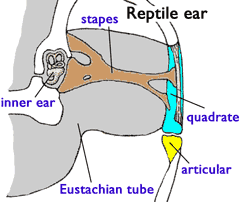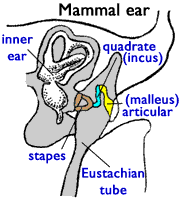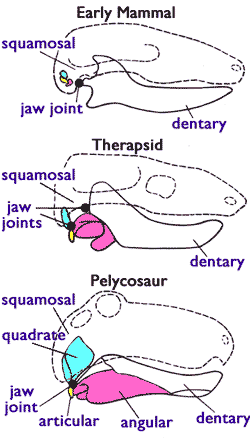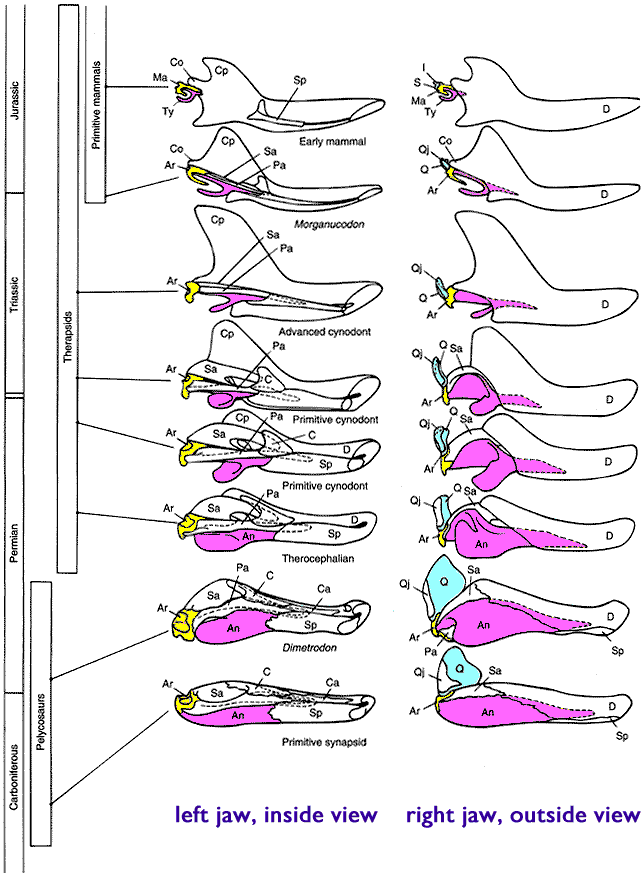|
|
|
Peptide
Skeptic Friend

USA
69 Posts |
|
|
filthy
SFN Die Hard

USA
14408 Posts |
 Posted - 10/12/2004 : 17:44:07 [Permalink] Posted - 10/12/2004 : 17:44:07 [Permalink]


|
I think I posted this earlier, but here it is again, anyway.
http://www.gcssepm.org/special/cuffey_05.htm
This should be of some asistance.
 |
"What luck for rulers that men do not think." -- Adolf Hitler (1889 - 1945)
"If only we could impeach on the basis of criminal stupidity, 90% of the Rethuglicans and half of the Democrats would be thrown out of office." ~~ P.Z. Myres
"The default position of human nature is to punch the other guy in the face and take his stuff." ~~ Dude
Brother Boot Knife of Warm Humanitarianism,
and Crypto-Communist! 
|
 |
|
|
Dude
SFN Die Hard

USA
6891 Posts |
 Posted - 10/12/2004 : 21:08:10 [Permalink] Posted - 10/12/2004 : 21:08:10 [Permalink]


|
I wouldn't use "irreducibly complex" to describe anything. Show the middle ear as a highly complex system, that clearly evolved, amd show the steps in that evolution, yes.
In effect, debunk the nonsense concept of "irreducible complexity" while presenting evidence that supports evolution. |
Ignorance is preferable to error; and he is less remote from the truth who believes nothing, than he who believes what is wrong.
-- Thomas Jefferson
"god :: the last refuge of a man with no answers and no argument." - G. Carlin
Hope, n.
The handmaiden of desperation; the opiate of despair; the illegible signpost on the road to perdition. ~~ da filth |
|
 |
|
|
Peptide
Skeptic Friend

USA
69 Posts |
 Posted - 10/13/2004 : 08:59:53 [Permalink] Posted - 10/13/2004 : 08:59:53 [Permalink]


|
quote:
Originally posted by Dude
I wouldn't use "irreducibly complex" to describe anything. Show the middle ear as a highly complex system, that clearly evolved, amd show the steps in that evolution, yes.
In effect, debunk the nonsense concept of "irreducible complexity" while presenting evidence that supports evolution.
I was hoping to debunk the concept of IC being unevolvable. I will simply claim that by removing one piece of the middle ear the whole system doesn't work. The same with the reptillian jaw. In this way it meets the criteria that Behe set out. Then, show how these things can change, keep their irreducible complexity, and still take on new functions. Also, the time scale for this change is in the millions of years which argues against IC systems coming about in "one fell swoop" and it is also more than a "just so story" but instead a story with it's pages in the fossil record. I will try to get this argument up today, but you guys may not have a whole lot of time to review it to see if my argument works in your opinions. I have used this argument on another board and it worked well. The only problem is that it took quite a few posts to fully support my argument which poses a problem in this debate. I will have to make a strong argument up front which may be difficult. |
 |
|
|
Peptide
Skeptic Friend

USA
69 Posts |
 Posted - 10/13/2004 : 09:08:37 [Permalink] Posted - 10/13/2004 : 09:08:37 [Permalink]


|
quote:
Originally posted by filthy
I think I posted this earlier, but here it is again, anyway.
http://www.gcssepm.org/special/cuffey_05.htm
This should be of some asistance.

This is exactly the type of reference that I was hoping to find. The picture from talkorigins did not display the rest of the fossil cranium. The site above does a great job of not only showing the evolution of the jaw/middle ear but also the differentation of teeth and the movement of cranial plates. Thanks a lot, I will definitely use it (and it uses offline references as well which is a plus). |
 |
|
|
filthy
SFN Die Hard

USA
14408 Posts |
 Posted - 10/13/2004 : 09:27:31 [Permalink] Posted - 10/13/2004 : 09:27:31 [Permalink]


|
De nada. Only too happy to help. I've used the Cuffy quite a bit. It is another that brought down the ad hom Wrath of Socranincompoop at TWeb.
I'm looking forward to the debate.
 |
"What luck for rulers that men do not think." -- Adolf Hitler (1889 - 1945)
"If only we could impeach on the basis of criminal stupidity, 90% of the Rethuglicans and half of the Democrats would be thrown out of office." ~~ P.Z. Myres
"The default position of human nature is to punch the other guy in the face and take his stuff." ~~ Dude
Brother Boot Knife of Warm Humanitarianism,
and Crypto-Communist! 
|
 |
|
|
Peptide
Skeptic Friend

USA
69 Posts |
 Posted - 10/14/2004 : 10:36:51 [Permalink] Posted - 10/14/2004 : 10:36:51 [Permalink]


|
This is the first rough draft, and I mean really rough. I hasn't been proof read so ignore grammatical errors for now.
For those with some extra time, I would like to include information showing how each step in the evolution of the mammalian middle ear confered an advantage over the previous transitional fossil. I will search for this later, but would appreciate some help.
Anyway, here it is:
--------------------------------------------
The Evolution of the Mammalian Middle Ear
Many claim that we do not have transitional fossils that show evolution in action. While we have few examples of fine grade transitions there are a large number of fossils demonstrating transitions between larger groups of organisms. The transition from reptile to mammal is one such transition where the fossil evidence is compelling.
One of the differences seen in the skeletal structure of reptiles and mammals is the middle ear and jaw bone. In reptiles, the lower jaw is made up of three bones (the dentary, articular, and quadrate) while the middle ear is made up of just one bone (the stapes). This is quite different from the mammalian structures where the lower jaw is made up of one bone (the dentary) and the middle ear is made up of three bones (the stapes, incus, and malleus). The middle ear is highlighted in these two illustrations:


From: http://www.talkorigins.org/faqs/comdesc/section1.html#morphological_intermediates_ex2
The interesting part is the functional difference between the two different arrangements. In the reptilian system, sound is transmitted through the three jaw bones, then through the middle ear, and then into the middle ear where it is decoded into nerve signals. The tympanum, or ear drum, also passes sound vibrations through the middle ear but not as effectively as seen in the mammalian system. This makes sense. Reptiles originally had limbs that exited their body parallel with the ground causing their jaw to rest on the ground. This allowed them to pick up the vibrations from prey as the moved across the ground. However, mammals have limbs that are perpendicular to the ground keeping their jaw off of the ground. Therefore, they need a better system for sensing air born sound waves. The three bone system in the mammalian middle ear does just that, improves on the single boned middle ear found in reptiles. The three boned system in mammals increases sensitivity and range of frequencies over that found in the single boned reptilian middle ear. The mammalian middle ear is beneficial and therefore was selected for through natural selection.
So, can the mammalian system evolve from a reptilian system? The first problem is how to keep both the jaw and middle ear functional throughout the evolution of the two systems. From the pictures above you will notice one hurdle: The malleus, at some point, must detach from the tympanum and allow the insertion of the incus and malleus. However, this is easily overcome if the both the stapes and incus/malleus are both touching the tympanum at the same time. This allows the removal of one of the bones at a later time. Secondly, how does the jaw work while all of these bones are moving around? The answer is a much like the first hurdle, by creating two hinges for the jaw, much like we see in snakes today:

From: http://www.talkorigins.org/faqs/comdesc/section1.html#morphological_intermediates_ex2
And here is a more complete fossil history of the reptile to mammal transition, highlighting the lower jaw and middle ear bones with the time scale on the left:

From: http://www.talkorigins.org/faqs/comdesc/section1.html#morphological_intermediates_ex2
An addit |
 |
|
|
filthy
SFN Die Hard

USA
14408 Posts |
 Posted - 10/14/2004 : 12:16:32 [Permalink] Posted - 10/14/2004 : 12:16:32 [Permalink]


|
Yes, excellent.
You won't need to use this, but snakes also pick up airborn, audio vibrations using their lung as a tynpanium as well as the lower jaw and skull.
Merely a point of interest I thought I'd toss in.
 |
"What luck for rulers that men do not think." -- Adolf Hitler (1889 - 1945)
"If only we could impeach on the basis of criminal stupidity, 90% of the Rethuglicans and half of the Democrats would be thrown out of office." ~~ P.Z. Myres
"The default position of human nature is to punch the other guy in the face and take his stuff." ~~ Dude
Brother Boot Knife of Warm Humanitarianism,
and Crypto-Communist! 
|
 |
|
|
Randy
SFN Regular

USA
1990 Posts |
 Posted - 10/14/2004 : 14:01:04 [Permalink] Posted - 10/14/2004 : 14:01:04 [Permalink]


|
Speaking of the ear, this interesting bit of news just in...
http://www.newsday.com/news/health/ny-hshear144005741oct14,0,7956212.story?coll=ny-health-headlines
snip:
>Researchers have long sought the missing link in the ear's conversion of sound waves into electrical signals that the brain can recognize as distinct sounds. In a study published yesterday in an online edition of the journal Nature, Harvard Medical School neurobiologist David Corey and 15 collaborators found a prime candidate in a tiny channel located at the tips of the inner ear's unusual hair cells - a channel shared among humans, mice, fish and even fruit flies. |
"We are all connected; to each other biologically, to the earth chemically, to the rest of the universe atomically."
"So you're made of detritus [from exploded stars]. Get over it. Or better yet, celebrate it. After all, what nobler thought can one cherish than that the universe lives within us all?"
-Neil DeGrasse Tyson |
 |
|
|
Dr. Mabuse
Septic Fiend

Sweden
9698 Posts |
 Posted - 10/14/2004 : 14:59:46 [Permalink] Posted - 10/14/2004 : 14:59:46 [Permalink]



|
quote:
Originally posted by Peptide
Another point that needs to be made is that the mammalian middle ear is an irreducibly complex (IC) system, much like the mouse trap example that Michael Behe uses in his writings. If one of those bones is removed then the whole system stops working. However, this system can be shown to evolve in a step wise manner. This is quite shocking, given Behe's position that IC systems can not evolve.
This looks like an attack on Behe, and his Irreducibly Complex system... Given tkster's track-record if interpreting his own rules, I'm afraid this section needs to be revised.
None the less, I think this is a very good argument. |
Dr. Mabuse - "When the going gets tough, the tough get Duct-tape..."
Dr. Mabuse whisper.mp3
"Equivocation is not just a job, for a creationist it's a way of life..." Dr. Mabuse
Support American Troops in Iraq:
Send them unarmed civilians for target practice..
Collateralmurder. |
| Edited by - Dr. Mabuse on 10/14/2004 15:00:42 |
 |
|
|
Ricky
SFN Die Hard

USA
4907 Posts |
|
|
Peptide
Skeptic Friend

USA
69 Posts |
 Posted - 10/14/2004 : 15:48:37 [Permalink] Posted - 10/14/2004 : 15:48:37 [Permalink]


|
quote:
Originally posted by Dr. Mabuse
This looks like an attack on Behe, and his Irreducibly Complex system... Given tkster's track-record if interpreting his own rules, I'm afraid this section needs to be revised.
None the less, I think this is a very good argument.
Ricky is right, it is a legit argument against Behe's ideas, not Behe himself. However, given the thin skin that many have towards other creationist's IDEAS being attacked I will rephrase it. The argument stays the same without even mentioning Behe's name.
What I am waiting for is this exchange:
tk: "The rules state that you can not use rebuttals in your first post so the IC stuff has to go"
Peptide: "Then JD can not use any anti-evolution arguments, only arguments that support special creation"
tk: "What's the difference between creationism and anti-evolutionism?"
Peptide: "What's the difference between evolution and anti-creationism?"
And around we go.
I hope this doesn't happen. We'll see. |
 |
|
|
Dave W.
Info Junkie

USA
26035 Posts |
 Posted - 10/14/2004 : 15:57:47 [Permalink] Posted - 10/14/2004 : 15:57:47 [Permalink]



|
Technically, jimi is supposed to only present the three best pro-creation arguments, anyway. The idea that evolution is wrong is not evidence for the Christian idea of special creation, as "evolution is wrong" is as equally "good" as evidence for, say, the Navaho idea about special creation, or Hindu creation, or Incan creation.
Actually, I suppose that since the type of creation jimi will be arguing for is not specified, it could be some strange amalgamation of "theories." Damn, that's a frightening idea. |
- Dave W. (Private Msg, EMail)
Evidently, I rock!
Why not question something for a change?
Visit Dave's Psoriasis Info, too. |
 |
|
|
Dr. Mabuse
Septic Fiend

Sweden
9698 Posts |
 Posted - 10/14/2004 : 16:02:55 [Permalink] Posted - 10/14/2004 : 16:02:55 [Permalink]



|
| Brilliant thinking, Peptide! |
Dr. Mabuse - "When the going gets tough, the tough get Duct-tape..."
Dr. Mabuse whisper.mp3
"Equivocation is not just a job, for a creationist it's a way of life..." Dr. Mabuse
Support American Troops in Iraq:
Send them unarmed civilians for target practice..
Collateralmurder. |
 |
|
|
Peptide
Skeptic Friend

USA
69 Posts |
 Posted - 10/15/2004 : 08:59:54 [Permalink] Posted - 10/15/2004 : 08:59:54 [Permalink]


|
Close to final product. I left out the pics to cut down on bandwidth but left the hyperlinks in place. I included a reference to the genetic link between the lower jaw in non-mammalian and the middle ear bones in the mammal. I also cleaned things up a bit and removed any direct mention of Behe. Let me know what you think.
----------------------------------------------
The Evolution of the Mammalian Middle Ear
Many claim that scientists do not have transitional fossils that display evolution in action. While it is true that scientists have few examples of fine grade transitions there are a large number of fossils demonstrating transitions between larger groups of organisms. The transition from reptile to mammal is one such transition where the fossil evidence is compelling.
One of the differences seen in the skeletal structure of reptiles and mammals is the middle ear and jaw bone. In reptiles, the lower jaw is made up of three bones (the dentary, articular, and quadrate) while the middle ear is made up of just one bone (the stapes). This is quite different from the mammalian structures where the lower jaw is made up of one bone (the dentary) and the middle ear is made up of three bones (the stapes, incus, and malleus). The middle ear in reptiles and mammals is highlighted in following two illustrations:
http://www.talkorigins.org/faqs/comdesc/section1.html#morphological_intermediates_ex2
Interestingly, the functional difference between the two arrangements differs. In the reptilian system, sound is transmitted through the three lower jaw bones, then through the middle ear, and then into the inner ear where the sound is transformed into nerve signals. The tympanum, or ear drum, also passes sound vibrations through the middle ear but not as effectively as seen in the mammalian system. This makes sense. Reptiles originally had limbs that exited their body parallel with the ground causing their jaw to rest on the ground. This allowed them to pick up the vibrations from prey as the moved across the ground. However, mammals have limbs that are perpendicular to the ground keeping their jaw off of the ground. Therefore, they need a better system for sensing airborn sound waves and less of a reliance on ground vibrations. The three bone system in the mammalian middle ear does just that, improves on the single boned middle ear found in reptiles. The three boned system in mammals increases sensitivity and range of frequencies to airborn sound waves over that found in the single boned reptilian middle ear. The mammalian middle ear is beneficial and therefore was selected for through natural selection.
So, can the mammalian system evolve from a reptilian system? The first problem is how to keep both the jaw and middle ear functional throughout the evolution of the two systems. From the pictures above you will notice one hurdle: The malleus, at some point, must detach from the eardrum and allow the insertion of the incus and malleus. However, this is easily overcome if the both the stapes and incus/malleus are both touching the tympanum at the same time. This allows the removal of one of the bones at a later time. Secondly, how does the jaw work while all of these bones are moving around? The answer is a much like the first hurdle, by creating two hinges for the jaw, much like we see in snakes today. Once the quadrate and articular are no longer needed, being that there is another functional jaw hinge, they are free to move up into the middle ear.
From: http://www.talkorigins.org/faqs/comdesc/section1.html#morphological_intermediates_ex2
And here is a more complete fossil history of the reptile to mammal transition, highlighting the lower jaw and middle ear bones with the time scale on the left:
From: http://www.talkorigins.org/faqs/comdesc/section1.html#morphological_intermediates_ex2
An additional illustration which also includes the rest of the cranium (and also a better textu |
 |
|
|
Peptide
Skeptic Friend

USA
69 Posts |
 Posted - 10/15/2004 : 10:07:15 [Permalink] Posted - 10/15/2004 : 10:07:15 [Permalink]


|
Close to final product. I left out the pics to cut down on bandwidth but left the hyperlinks in place. I included a reference to the genetic link between the lower jaw in non-mammalian and the middle ear bones in the mammal. I also cleaned things up a bit and removed any direct mention of Behe. Let me know what you think.
----------------------------------------------
The Evolution of the Mammalian Middle Ear
Many claim that scientists do not have transitional fossils that display evolution in action. While it is true that scientists have few examples of fine grade transitions there are a large number of fossils demonstrating transitions between larger groups of organisms. The transition from reptile to mammal is one such transition where the fossil evidence is compelling.
One of the differences seen in the skeletal structure of reptiles and mammals is the middle ear and jaw bone. In reptiles, the lower jaw is made up of three bones (the dentary, articular, and quadrate) while the middle ear is made up of just one bone (the stapes). This is quite different from the mammalian structures where the lower jaw is made up of one bone (the dentary) and the middle ear is made up of three bones (the stapes, incus, and malleus). The middle ear in reptiles and mammals is highlighted in following two illustrations:
http://www.talkorigins.org/faqs/comdesc/section1.html#morphological_intermediates_ex2
Interestingly, the functional difference between the two arrangements differs. In the reptilian system, sound is transmitted through the three lower jaw bones, then through the middle ear, and then into the inner ear where the sound is transformed into nerve signals. The tympanum, or ear drum, also passes sound vibrations through the middle ear but not as effectively as seen in the mammalian system. This makes sense. Reptiles originally had limbs that exited their body parallel with the ground causing their jaw to rest on the ground. This allowed them to pick up the vibrations from prey as the moved across the ground. However, mammals have limbs that are perpendicular to the ground keeping their jaw off of the ground. Therefore, they need a better system for sensing airborn sound waves and less of a reliance on ground vibrations. The three bone system in the mammalian middle ear does just that, improves on the single boned middle ear found in reptiles. The three boned system in mammals increases sensitivity and range of frequencies to airborn sound waves over that found in the single boned reptilian middle ear. The mammalian middle ear is beneficial and therefore was selected for through natural selection.
So, can the mammalian system evolve from a reptilian system? The first problem is how to keep both the jaw and middle ear functional throughout the evolution of the two systems. From the pictures above you will notice one hurdle: The malleus, at some point, must detach from the eardrum and allow the insertion of the incus and malleus. However, this is easily overcome if the both the stapes and incus/malleus are both touching the tympanum at the same time. This allows the removal of one of the bones at a later time. Secondly, how does the jaw work while all of these bones are moving around? The answer is a much like the first hurdle, by creating two hinges for the jaw, much like we see in snakes today. Once the quadrate and articular are no longer needed, being that there is another functional jaw hinge, they are free to move up into the middle ear.
From: http://www.talkorigins.org/faqs/comdesc/section1.html#morphological_intermediates_ex2
And here is a more complete fossil history of the reptile to mammal transition, highlighting the lower jaw and middle ear bones with the time scale on the left:
From: http://www.talkorigins.org/faqs/comdesc/section1.html#morphological_intermediates_ex2
An additional illustration which also includes the rest of the cranium (and also a better textu |
 |
|
 |
|
|
|
![]()